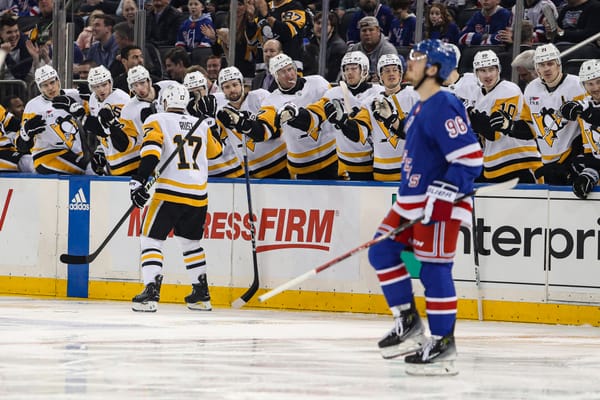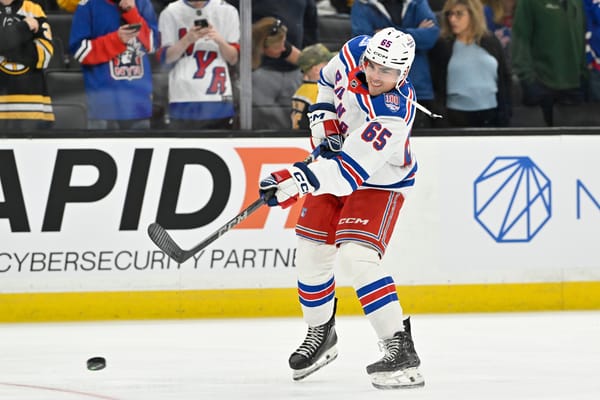Setting Expectations for the Rangers’ Sophomores
Last season, the Rangers experienced a youth movement unlike any other they’ve gone through since emerging from the lockout more than a decade ago. With Pavel Buchnevich, Brady Skjei, and Jimmy Vesey all primed to play major roles heading into the season, plenty of question marks surrounded the team due to having three rookies expected to play prominent roles. As the season progressed, the trio of players had their individual ups and downs. Some of those were self-inflicted, while some were the results of circumstance and opportunity.
Regardless of how or why things played out the way they did last season, expectations for those three players in particular have been raised. The general consensus of Rangerstown seems to be that Skjei and Vesey excelled when given the opportunity, while Buchnevich’s struggles with injuries and “inconsistency” (which is a great word to use to knock a player down when you can’t point out anything particularly bad about their game) has given the team’s Russian winger plenty of room to improve.
However, expecting major improvements across the board from all three players could leave many fans disappointed. While nobody should expect the trio to experience the dreaded sophomore slump, tempering expectations would be wise. Expecting Brady Skjei and Pavel Buchnevich to become Ryan McDonagh and Vladimir Tarasenko over one summer is beyond unreasonable, so setting reasonable expectations is key in order to avoid being disappointed.
Brady Skjei’s rookie season was a lot like going on a roller coaster for the first time. You have a general idea of what to expect before heading on, as Skjei was expected to be an NHL-caliber defenseman from opening night and eventually establish himself in the team’s top 4.
Once the roller coaster, you immediately regret strapping in and ridding the coaster because you didn’t expect it to be as bad as it ended up being. That was the story of Skjei’s first half, as he was absolutely abhorrent from opening night until the all-star break. Eventually, you get used to the coaster and by the time you step off and move on, you’re happy you experienced the ride. That was the tale of Skjei’s second half, where his play improved drastically from January until the playoffs, culminating in an excellent twelve playoff games.
If Skjei can reprise his play from the second half of last season, then New York’s defense corps should emerge as one of the league’s upper echelon groups. Expecting Skjei’s point production (1.41 5-on-5 Points/60, 4th most among defenseman) to remain the same is a bit of a stretch, so even if he fails to eclipse 40 points after scoring 39 last season, it shouldn’t be used as a major detraction against him. However, if Skjei regresses and plays like he did throughout the first half of 16-17, then the Rangers will be in trouble.
As for Buchnevich and Vesey, New York’s duo of sophomore forwards couldn’t have had more different rookie campaigns. After bursting out of the gate with six goals and three assists in his first ten games, Vesey’s season was unremarkable at best. Despite spending most of his time on lines with Derek Stepan and Rick Nash, Vesey struggled for the rest of the season, notching ten goals and eight assists over his final 70 contests. He added a goal and three assists in the playoffs, notching two points in each series against Montreal and Ottawa.
For a player who spent nearly the entire season in the top nine with quality linemates, production like that isn’t going to cut it going forward. Using rate metrics paints an even gloomier picture, as Vesey’s 1.20 Points/60 at even strength was second last among forwards, only outscoring Brandon Pirri.
The notion that that Vesey is a crucial part of New York’s success moving forward while Buehnevich’s development is a lesser issue is prevalent in certain portions of the hockey world. Unfortunately, nothing about that notion is based in reality, as Jeff Gorton could sign a player off the street tomorrow, plug him into Vesey’s lineup spot, and be better off for it:
As you can see, the comparison between Vesey and a league average 4th line player isn’t flattering for Vesey. Barring a major leap in his development this season, New York’s best bet will likely be to let him play out the majority of the season, and re-evaluate at the trade deadline. Vesey has more value as trade chip for the organization than he does as a mediocre winger for Alain Vigneault. Using him as a piece to land an upgrade down the middle would be a shrewd move by Gorton, and would vault the team into Stanley Cup contention.
Unlike Vesey, Pavel Buchnevich’s rookie season seems to be underrated given the circumstances he had to persevere through. After opening the season with an assist in his NHL debut, Buchnevich would play one more game before exiting the lineup due to injury for nearly two weeks.
After returning, Buchnevich went on a tear, scoring four goals and three assists over his next nine games before landing on injured reserve yet again. This time, Buchnevich would remain out of commission for two months spanning from November 12th before returning to action on January 13th. The Rangers took a cautious approach with their prized rookie, as they had Buchnevich undergo a “core-strengthening program” during his time away in the hopes of reducing further injury risk.
He returned to the lineup with a bang, scoring two goals and four assists over his next four games. After the all-star break, Alain Vigneault elected to shuffle his lineup, and Buchnevich found himself in the unenviable position as one of the team’s regular 4th liners. Despite only earning six points for the remainder of the season, Buchnevich still managed to lead New York with 2.12 Points/60 at even strength. By the time the playoffs rolled around, Buchnevich had joined the prestigious club of players sent to the press box in favor of Tanner Glass, and he only appeared in five playoff games.
As a wise man once said, dependability is more important than ability. While Buchnevich doesn’t control how or when he could injured, staying healthy will be the top goal for both Buchnevich personally, and the Rangers’ organization’s expectations of him. The comparisons to players like Tarasenko and Evgeny Kuznetsov haven’t come from thin air, so if Buchnevich can stay healthy, his talent will be on display and the results will come.
Now that the three players have experienced the grind of an 82 game NHL season, expectations have been raised. Brady Skjei will look to solidify himself on the left side of New York’s second pairing for years to come. Jimmy Vesey will look to improve on his sub-par effort from last year and develop into something more than a spare part. Pavel Buchnevich will look to bounce back from his injury-plagued 16-17 campaign and emerge as the bona fide top six forward talking heads throughout the hockey world have projected him to become.
Setting expectations any higher would be setting people up for disappointment. Setting them any lower would be doing a disservice to each of the players and the talent they possess. If all three of Skjei, Vesey, and Buchnevich can reach or surpass their expectations, than the Rangers will be in good shape for the 17-18 season.





